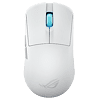 4
4
ASUS ROG Harpe Ace Mini Review
Sensor & Performance »Build Quality
Overall build quality is very solid. There is no rattle when shaking the mouse. When applying lateral pressure, no creaking or flexing of the top shell can be observed. Activating the side buttons by squeezing the sides is impossible. Lastly, accidental clicks when slamming down the mouse do not occur.Buttons
Main buttons on the Harpe Ace Mini are good to decent. Pre-travel is moderate to high, whereas post-travel is moderate, resulting in a fairly firm and snappy button response, though the right button is mushier than the left one. Despite being visually separated from the shell, button movement is minimal even when provoked. Button stiffness is light. A pair of ROG Optical Micro Switches (100 M) are used.
Side buttons are very good. Pre and post-travel are very low, and while feedback is a bit lacking, the button response is pleasant. The actuation point is even across the entirety of these. Button size and placement are good, as actuation is possible rather easily by rolling one's thumb across. A set of surface-mounted Kailh switches (yellow plunger) are used for these.
At the bottom of the mouse is a button for cycling through the set CPI levels, which works just fine, along with a button for device pairing. A seemingly unbranded tactile switch is used for both. A slider at the bottom switches between 2.4 GHz wireless, Bluetooth, and off-state, which also works fine.
Scroll Wheel
The scroll wheel is good. Noise levels are somewhat elevated, though tactility is above average, as the individual steps are decently separated from each other. The encoder comes from TTC (blue, yellow core) and has a height of 9 mm. The middle (scroll wheel) click requires medium force for actuation. A seemingly unbranded tactile switch (black plunger) is used for this one.
Surface
The Harpe Ace Mini has a matte surface all over. Grip is fine, and it doesn't attract fingerprints or dirt too much. It is easy to clean, and there are no signs of wear left after doing so. That said, the riffle pattern at the grip area on the sides is prone to catching dirt, and cleaning it can be difficult. All in all, very good materials.Button Sound Test
Disassembly
Disassembling the Harpe Ace Mini is easy. The two screws are found beneath the rear skates. After removing those, top and bottom shell are readily separated, though some caution needs to be applied to avoid ripping the cable connecting the two.
The internal design is reasonably efficient. The side buttons sit on their own PCB slotted into a plastic assembly part of the bottom shell and connected through an FFC. The same FFC also connects to the scroll wheel providing illumination through an LED. The somewhat spacious main PCB is thin and affixed to the bottom with four screws. The battery is placed on the bottom shell towards the rear. The MCU is a Nordic nRF52840, whose datasheet can be found here. Production date for the main PCB is the 27th week of 2024.
As for the soldering and general quality of the PCB, I'm unable to find any noteworthy flaws.
Feb 28th, 2025 12:35 EST
change timezone
Latest GPU Drivers
New Forum Posts
- I5 10300H undervolting ,need to stop thermal throttle (1)
- It's happening again, melting 12v high pwr connectors (957)
- K7 Thermal Pad. What is that? (1)
- Basic web browsing PC (13)
- i7-13700HX not overclocking (14)
- DELL ALIENWARE AW2523HF COIL WHINE NOISE. (3)
- WB actually did it...They closed Monolith. :( (41)
- What are you playing? (23054)
- Amd rx570 sapphire nitro 8gb+ not detected (19)
- The TPU Darkroom - Digital SLR and Photography Club (4062)
Popular Reviews
- AMD Radeon RX 9070 Series Technical Deep Dive
- ASUS GeForce RTX 5070 Ti TUF OC Review
- Montech HyperFlow Silent 360 Review
- Gigabyte X870 Aorus Elite WiFi 7 Review
- Corsair Xeneon 34WQHD240-C Review - Pretty In White
- be quiet! Pure Base 501 DX Review
- AMD Ryzen 7 9800X3D Review - The Best Gaming Processor
- MSI GeForce RTX 5070 Ti Vanguard SOC Review
- ASUS ROG Harpe Ace Mini Review
- MSI GeForce RTX 5070 Ti Ventus 3X OC Review
Controversial News Posts
- NVIDIA GeForce RTX 50 Cards Spotted with Missing ROPs, NVIDIA Confirms the Issue, Multiple Vendors Affected (498)
- AMD Radeon 9070 XT Rumored to Outpace RTX 5070 Ti by Almost 15% (304)
- AMD Plans Aggressive Price Competition with Radeon RX 9000 Series (274)
- AMD Radeon RX 9070 and 9070 XT Listed On Amazon - One Buyer Snags a Unit (255)
- NVIDIA Investigates GeForce RTX 50 Series "Blackwell" Black Screen and BSOD Issues (244)
- AMD Mentions Sub-$700 Pricing for Radeon RX 9070 GPU Series, Looks Like NV Minus $50 Again (242)
- Edward Snowden Lashes Out at NVIDIA Over GeForce RTX 50 Pricing And Value (242)
- AMD Radeon RX 9070 and 9070 XT Official Performance Metrics Leaked, +42% 4K Performance Over Radeon RX 7900 GRE (191)








